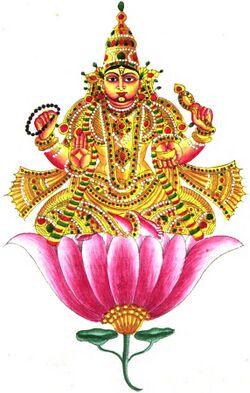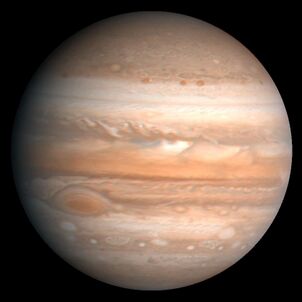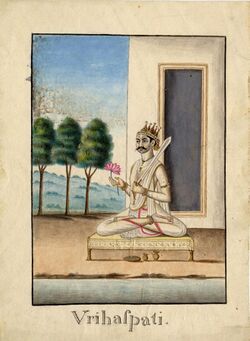Astronomy:Bṛhaspati
| Brihaspati | |
|---|---|
The Teacher of the Gods, Jupiter | |
| Member of Navagraha | |
 Brihaspati | |
| Affiliation | Deva (Graha) |
| Abode | Devloka |
| Planet | Jupiter |
| Mantra | Om Brihaspataye Namaha |
| Day | Thursday |
| Mount | Elephant / chariot drawn by eight white horses |
| Personal information | |
| Parents |
|
| Consort | Tara[1] |
| Children | Bharadwaja, Kacha, Kesari (sons) |
Bṛhaspati (Sanskrit: बृहस्पति; meaning spati of briha, the spirit of vastness of the universe written as Brihaspati) is an Indian name, and refers to different mythical figures depending on the age of the text.[2] In ancient Hindu literature Brihaspati is a Vedic era sage who counsels the gods,[3][4] while in some medieval texts the word refers to the largest planet of the solar system, Jupiter.[5] He taught Bhishma the duties of a king which he later taught it to Vidura.
Sage
Bṛhaspati appears in the Rigveda (pre-1000 BCE), such as in the dedications to him in the hymn 50 of Book 4;[6] he is described as a sage born from the first great light, the one who drove away darkness, is bright and pure, and carries a special bow whose string is Rta or "cosmic order" (basis of dharma).[5][7] His knowledge and character is revered, and he is considered Guru (teacher) by all the Devas.[2] In the Vedic literature and other ancient texts, sage Brihaspati is also called by other names such as Bramanaspati, Purohita, Angirasa (son of Angiras) and Vyasa;[3] he is sometimes identified with god Agni (fire). His wife is Tara (or goddess who personifies the stars in the sky).[5]
The reverence for sage Brihaspati endured through the medieval period, and one of the many Dharmasastras was named after him.[8][9][10] While the manuscripts of Brihaspati Smriti (Bṛhaspatismṛti) have not survived into the modern era, its verses were cited in other Indian texts. Scholars have made an effort to extract these cited verses, thus creating a modern reconstruction of Bṛhaspatismriti.[11] Jolly and Aiyangar have gathered some 2,400 verses of the lost Bṛhaspatismṛti text in this manner.[11] Brihaspati Smriti was likely a larger and more comprehensive text than Manusmriti,[11] and the available evidence suggests that the discussion of the judicial process and jurisprudence in Brihaspati Smriti was often cited.[12][13]
Brhaspati sutras
Brhaspati sutras, also called the Barhaspatya sutras, is an ancient Sanskrit text named after its author Brhaspati, known for its theories of materialism and anti-theism.[14][15] Its tenets are at the foundation of the Charvaka school of non-orthodox Indian philosophy.[16][17] The Brihaspati Sutras manuscript has been lost to history or yet to be found.[18][16] However, the text is quoted in other Hindu, Buddhist and Jaina texts, and this secondary literature has been the source for reconstructing the Brhaspati sutras partially.[18][19]
Some scholars suggest that Brhaspati sutras are named after Brhaspati in the Vedas, but other scholars dispute this theory because the text rejects the Vedas.[20]
Planet
Brhaspati as a planet (Jupiter) appears in various Hindu astronomical texts in Sanskrit, such as the 5th century Aryabhatiya by Aryabhata, the 6th century Romaka by Latadeva and Panca Siddhantika by Varahamihira, the 7th century Khandakhadyaka by Brahmagupta and the 8th century Sisyadhivrddida by Lalla.[21] These texts present Brhaspati as one of the planets and estimate the characteristics of the respective planetary motion.[21] Other texts such as Surya Siddhanta dated to have been complete sometime between the 5th century and 10th century present their chapters on various planets with deity mythologies.[21]
The manuscripts of these texts exist in slightly different versions, present Brhaspati's motion in the skies, but vary in their data, suggesting that the text were open and revised over their lives.[22] The texts slightly disagree in their data, in their measurements of Brhaspati's revolutions, apogee, epicycles, nodal longitudes, orbital inclination, and other parameters.[23][24] For example, both Khandakhadyaka and Surya Siddhanta of Varaha state that Brhaspati completes 364,220 revolutions every 4,320,000 earth years, an Epicycle of Apsis as 32 degrees, and had an apogee (aphelia) of 160 degrees in 499 CE; while another manuscript of Surya Siddhanta accepts the revolutions to be 364,220, but revises the apogee to 171 degrees and 16 seconds and the Epicycle slightly.[25]
The 1st millennium CE Hindu scholars had estimated the time it took for sidereal revolutions of each planet including Brhaspati, from their astronomical studies, with slightly different results:[26]
| Source | Estimated time per sidereal revolution[26] |
| Surya Siddhanta | 4,332 days, 7 hours, 41 minutes, 44.4 seconds |
| Siddhanta Shiromani | 4,332 days, 5 hours, 45 minutes, 43.7 seconds |
| Ptolemy | 4,332 days, 18 hours, 9 minutes, 10.5 seconds |
| 20th century calculations | 4,332 days, 14 hours, 2 minutes, 8.6 seconds |
Zodiac
In medieval mythologies particularly those associated with Hindu astrology, Brihaspati has a second meaning and refers to Jupiter.[5][2] It became the root of the word 'Brihaspativara' or Thursday in the Hindu calendar.[5] Brihaspati as Jupiter is part of the Navagraha in Hindu zodiac system, considered auspicious and benevolent. The word "Thursday" in the Greco-Roman and other Indo-European calendars is also dedicated to planet Jupiter (god of sky and thunder).[27][28][29] Their zodiac signs being nearly identical.
Brihaspati is a part of the Navagraha in Hindu zodiac system. The role and importance of the Navagraha developed over time with various influences. Deifying the sun and its astrological significance occurred as early as the Vedic period and was recorded in the Vedas. The earliest work of astrology recorded in India is the Vedanga Jyotisha which began to be compiled in the 14th century BCE. It was possibly based on works from the Indus Valley Civilization as well as various foreign influences. Babylonian astrology which was the first to develop astrology and the calendar, and was adopted by multiple civilizations including India.
The Navagraha developed from early works of astrology over time. The Sun and various classical planets were referenced in the Atharvaveda around 1000 BCE. The Navagraha was furthered by additional contributions from Western Asia, including Zoroastrian and Hellenistic influences. The Yavanajataka, or 'Science of the Yavanas', was written by the Indo-Greek named "Yavanesvara" ("Lord of the Greeks") under the rule of the Western Kshatrapa king Rudrakarman I. The Yavanajataka written in 120 CE is often attributed to standardizing Indian astrology. The Navagraha would further develop and culminate in the Shaka era with the Saka, or Scythian, people. Additionally the contributions by the Saka people would be the basis of the Indian national calendar, which is also called the Saka calendar.
The Hindu calendar is a Lunisolar calendar which records both lunar and solar cycles. Like the Navagraha, it was developed with the successive contributions of various works.
Iconography
The icon of Brihaspati makes his body golden, with his legs striped blue and his head covered with a halo of moon and stars.[3] He holds different items depending on the region. In parts of South Asia he holds a container containing soma, sometimes with a tamed tiger.[3] Elsewhere, his icon carries a stick, a lotus and beads.[30][full citation needed] Brihaspati was married to Tara. In medieval mythologies, Tara was abducted by Chandra. Tara bore a son, Budha (planet Mercury).[31]
Dedicated day
Thursday is considered to be the dedicated day for Brihaspati. According Hindu mythology, praying to Brihaspati on Thursday provides astrological benefits. [32]
See also
References
- ↑ https://books.google.co.in/books?redir_esc=y&id=DH0vmD8ghdMC&q=Brihaspati#v=snippet&q=Brihaspati&f=false
- ↑ 2.0 2.1 2.2 James G. Lochtefeld (2002). The Illustrated Encyclopedia of Hinduism: A-M. The Rosen Publishing Group. p. 127. ISBN 978-0-8239-3179-8. https://archive.org/details/illustratedencyc0000loch.
- ↑ 3.0 3.1 3.2 3.3 Charles Russell Coulter; Patricia Turner (2013). Encyclopedia of Ancient Deities. Routledge. p. 108. ISBN 978-1-135-96390-3. https://books.google.com/books?id=sEIngqiKOugC&pg=PA108.
- ↑ Walter Slaje (2008). Abhandlungen für die Kunde des Morgenlandes. Otto Harrassowitz Verlag. pp. 157 with footnotes. ISBN 978-3-447-05645-8. https://books.google.com/books?id=fD0Ypvxmzj8C.
- ↑ 5.0 5.1 5.2 5.3 5.4 Roshen Dalal (2010). Hinduism: An Alphabetical Guide. Penguin Books India. p. 86. ISBN 978-0-14-341421-6. https://books.google.com/books?id=DH0vmD8ghdMC&pg=PA86.
- ↑ ऋग्वेद: सूक्तं ४.५०, Wikisource (Sanskrit text of Rigveda)
- ↑ Hervey De Witt Griswold (1971). The Religion of the Ṛigveda. Motilal Banarsidass. pp. 168–170. ISBN 978-81-208-0745-7. https://books.google.com/books?id=Vhkt5K1fw2wC&pg=PA168.
- ↑ Robert Lingat 1973, p. 277.
- ↑ Mandagadde Rama Jois 1984, pp. 22.
- ↑ Benoy Kumar Sarkar (1985). The Positive Background of Hindu Sociology. Motilal Banarsidass. pp. 192–194. ISBN 978-81-208-2664-9. https://archive.org/details/positivebackgrou0000sark.
- ↑ 11.0 11.1 11.2 Robert Lingat 1973, p. 104.
- ↑ Patrick Olivelle 2006, p. 188.
- ↑ Robert Lingat 1973, pp. 14, 109–110, 180–189.
- ↑ Bhattacharya 2002.
- ↑ YaleUniversity (2014-10-24), Dwight H. Terry Lecture: "How Widespread Was Skepticism In Ancient India?", https://www.youtube.com/watch?v=G9TDl1xiCgU, retrieved 2016-10-04
- ↑ 16.0 16.1 John M. Koller (1977), Skepticism in Early Indian Thought, Philosophy East and West, 27(2): 155–164
- ↑ CV Vaidya (2001). Epic India, Or, India as Described in the Mahabharata and the Ramayana. Asian Educational Services. p. 503. ISBN 978-81-206-1564-9. https://books.google.com/books?id=dmOUq73LZLgC. "Quote: These atheistical doctrines existed from the earliest times as their traces are visible even in the Rigveda in some hymns of which Prof Max Muller pointed out the curious traces of an incipient scepticism. (...) Two things are therefore clear that the Brihaspatya tenets also called Charvaka tenets are of a very old standing...""
- ↑ 18.0 18.1 Radhakrishnan 1957, pp. 227–249.
- ↑ Bhattacharya 2011, pp. 21–44, 65–74.
- ↑ Jeaneane Fowler (2015). A. C. Grayling. ed. The Wiley Blackwell Handbook of Humanism. John Wiley & Sons. pp. 114 with footnote 17. ISBN 978-1-119-97717-9. https://books.google.com/books?id=8BotCgAAQBAJ&pg=PA114.
- ↑ 21.0 21.1 21.2 Ebenezer Burgess (1989). P Ganguly, P Sengupta. ed. Sûrya-Siddhânta: A Text-book of Hindu Astronomy. Motilal Banarsidass (Reprint), Original: Yale University Press, American Oriental Society. pp. vii–xi. ISBN 978-81-208-0612-2. https://books.google.com/books?id=W0Uo_-_iizwC.
- ↑ Lionel D. Barnett (1994). Antiquities of India: An Account of the History and Culture of Ancient Hindustan. Asian Educational Services. pp. 190–192. ISBN 978-81-206-0530-5. https://books.google.com/books?id=x40mwFwgK44C&pg=PA190.
- ↑ Ebenezer Burgess (1989). P Ganguly, P Sengupta. ed. Sûrya-Siddhânta: A Text-book of Hindu Astronomy. Motilal Banarsidass (Reprint), Original: Yale University Press, American Oriental Society. pp. ix–xi, xxix. ISBN 978-81-208-0612-2. https://books.google.com/books?id=W0Uo_-_iizwC.
- ↑ J Fleet (1911). "Arbhatiya". Journal of the Royal Asiatic Society of Great Britain and Ireland: 794–799. https://books.google.com/books?id=1LssAAAAIAAJ.
- ↑ Ebenezer Burgess (1989). P Ganguly, P Sengupta. ed. Sûrya-Siddhânta: A Text-book of Hindu Astronomy. Motilal Banarsidass (Reprint), Original: Yale University Press, American Oriental Society. pp. ix–x. ISBN 978-81-208-0612-2. https://books.google.com/books?id=W0Uo_-_iizwC.
- ↑ 26.0 26.1 Ebenezer Burgess (1989). P Ganguly, P Sengupta. ed. Sûrya-Siddhânta: A Text-book of Hindu Astronomy. Motilal Banarsidass (Reprint), Original: Yale University Press, American Oriental Society. pp. 26–27. ISBN 978-81-208-0612-2. https://books.google.com/books?id=W0Uo_-_iizwC.
- ↑ Yukio Ohashi 1999, pp. 719–721.
- ↑ Pingree 1973, pp. 2–3.
- ↑ Erik Gregersen (2011). The Britannica Guide to the History of Mathematics. The Rosen Publishing Group. p. 187. ISBN 978-1-61530-127-0. https://books.google.com/books?id=qZ3zVmLUcjcC.
- ↑ Coleman, Charles. Mythology of the Hindus, p. 133
- ↑ George Mason Williams (2003). Handbook of Hindu Mythology. ABC-CLIO. p. 91. ISBN 978-1576071069. https://archive.org/details/isbn_9791576071068. Retrieved 17 July 2015.
- ↑ "Who is Dev Guru Brihaspati, Guru of all Hindu gods?". https://brihaspatidham.com/bd-about-dev-guru-brihaspati.
Bibliography
- Bhattacharya, Ramakrishna (2011). Studies on the Carvaka/Lokayata (Cultural, Historical and Textual Studies of Religions. Anthem. ISBN 978-0857284334.
- Bhattacharya, Ramakrishna (2002). "Cārvāka Fragments: A New Collection". Journal of Indian Philosophy 30 (6): 597–640.
- Pingree, David (1973). "The Mesopotamian Origin of Early Indian Mathematical Astronomy". Journal for the History of Astronomy 4 (1): 1–12. doi:10.1177/002182867300400102. Bibcode: 1973JHA.....4....1P.
- Pingree, David (1981). Jyotihśāstra : Astral and Mathematical Literature. Otto Harrassowitz. ISBN 978-3447021654.
- Yukio Ohashi (1999). Johannes Andersen. ed. Highlights of Astronomy, Volume 11B. Springer Science. ISBN 978-0-7923-5556-4. https://books.google.com/books?id=gQYscrT0fgQC.
- Bali, Saraswati (1978). Bṛhaspati in the Vedas and the Purāṇas. Delhi: Nag Publishers. https://books.google.com/?id=mJITAAAAMAAJ.
- Parpola, Asko (3 July 2015). The Roots of Hinduism: The Early Aryans and the Indus Civilization. Oxford University Press. pp. 111–114. ISBN 978-0-19-022693-0. https://books.google.com/books?id=DagXCgAAQBAJ&pg=PA114.
- Radhakrishnan, Sarvepalli and Moore, Charles (1957). A Source Book in Indian Philosophy. Princeton University Press. ISBN 978-0-691-01958-1. https://archive.org/details/sourcebookinindi00radh.
- Klostermaier, Klaus (1 October 2014). A Concise Encyclopedia of Hinduism. Oneworld Publications. p. 56. ISBN 978-1-78074-672-2. https://books.google.com/books?id=v1UQBwAAQBAJ&pg=PT56.
- Mandagadde Rama Jois (1984). Legal and Constitutional History of India: Ancient legal, judicial, and constitutional system. Universal Law Publishing. ISBN 978-81-7534-206-4. https://books.google.com/books?id=V552bAz5xFAC.
- Robert Lingat (1973). The Classical Law of India. University of California Press. ISBN 978-0-520-01898-3. https://books.google.com/books?id=Sauo8iSIj7YC.
- Patrick Olivelle (1999). Dharmasutras: The Law Codes of Ancient India. Oxford University Press. ISBN 978-0-19-283882-7. https://books.google.com/books?id=gnVxqvPg9a0C.
- Patrick Olivelle (2006). Between the Empires: Society in India 300 BCE to 400 CE. Oxford University Press. ISBN 978-0-19-977507-1. https://books.google.com/books?id=efaOR_-YsIcC.
External links



